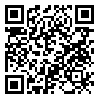Mon, Dec 8, 2025
[Archive]
Volume 13, Issue 4 (12-2021)
itrc 2021, 13(4): 1-7 |
Back to browse issues page
Download citation:
BibTeX | RIS | EndNote | Medlars | ProCite | Reference Manager | RefWorks
Send citation to:



BibTeX | RIS | EndNote | Medlars | ProCite | Reference Manager | RefWorks
Send citation to:
Gholami M, Sadeghi E, Neshat M. A New Look at the Coding in Time-Modulated Arrays. itrc 2021; 13 (4) :1-7
URL: http://ijict.itrc.ac.ir/article-1-493-en.html
URL: http://ijict.itrc.ac.ir/article-1-493-en.html
1- School of Electrical and Computer Engineering, College of Engineering, University of Tehran, Tehran, Iran
2- School of Electrical and Computer Engineering, College of Engineering, University of Tehran, Tehran, Iran ,mneshat@ut.ac.ir
2- School of Electrical and Computer Engineering, College of Engineering, University of Tehran, Tehran, Iran ,
Abstract: (3843 Views)
In this paper, we show that the digital code bits used in the coded time-modulated arrays (TMA) can be interpreted as vector elements, and with this new interpretation, a better understanding of the relationship between the codes and the amplitude/phase of the generated harmonic signals is obtained. Using such interpretation, we first select the proper codes for the maximum radiation in a coded TMA, and then we show that one can easily perform the beam steering in a TMA by electronically shifting the bits of the selected codes. Through full-wave simulations, we demonstrate the beam steering of a TMA without the use of any phase shifter, and only by shifting the digital code bits. The proposed interpretation can play an important role in reducing the complexity of the code selection in controlling of TMAs.
Keywords: Antenna array, Beam steering, Digital code, Metasurface, Time-coded modulation, Time modulated array
Subject:
Communication Technology
References
1. [1] R. W. Bickmore and R. Hansen, “Time versus space in antenna theory,” Microwave scanning antennas, vol. 3, p. 15, 1966.
[2] H. E. Shanks and R. W. Bickmore, “Four-dimensional electromagnetic radiators,” Canadian Journal of Physics, vol. 37, no. 3, pp. 263–275, 1959.
[3] G. Franceschetti, J. Tatoian, and G. Gibbs, “Timed arrays in a nutshell,” IEEE transactions on antennas and propagation, vol. 53, no. 12, pp. 4073–4082, 2005.
[4] A. Chakraborty, G. Ram, and D. Mandal, “Time-modulated multibeam steered antenna array synthesis with optimally designed switching sequence,” International Journal of Communication Systems, vol. 34, no. 9, p. e4828, 2021.
[5] G. Bogdan, K. Godziszewski, and Y. Yashchyshyn, “Time-modulated antenna array with beam-steering for low-power wide-area network receivers,” IEEE Antennas and Wireless Propagation Letters, vol. 19, no. 11, pp. 1876–1880, 2020.
[6] T. J. Cui, S. Liu, G. D. Bai, and Q. Ma, “Direct transmission of digital message via programmable coding metasurface,” Research, vol. 2019, 2019.
[7] W. Tang, M. Z. Chen, J. Y. Dai, Y. Zeng, X. Zhao, S. Jin, Q. Cheng, and T. J. Cui, “Wireless communications with programmable metasurface: New paradigms, opportunities, and challenges on transceiver design,” IEEE Wireless Communications, vol. 27, no. 2, pp. 180–187, 2020.
[8] S. Taravati and A. A. Kishk, “Space-time modulation: Principles and applications,” IEEE Microwave Magazine, vol. 21, no. 4, pp. 30–56, 2020.
[9] S. Vakalis and J. A. Nanzer, “Millimeter-wave angle estimation of multiple targets using space-time modulation and interferometric antenna arrays,” IEEE Transactions on Microwave Theory and Techniques, pp. 1– 1, 2021.
[10] W. Kummer, A. Villeneuve, T. Fong, and F. Terrio, “Ultra-low sidelobes from time-modulated arrays,” IEEE Transactions on Antennas and Propagation, vol. 11, no. 6, pp. 633–639, 1963.
[11] J. Y. Dai, J. Zhao, Q. Cheng, and T. J. Cui, “Independent control of harmonic amplitudes and phases via a time-domain digital coding metasurface,” Light: Science & Applications, vol. 7, no. 1, p. 90, 2018.
[12] E. T. Bekele, L. Poli, P. Rocca, M. d’Urso, and A. Massa, “Pulseshaping strategy for time modulated arrays—analysis and design,” IEEE Transactions on Antennas and Propagation, vol. 61, no. 7, pp. 3525– 3537, 2013.
[13] R. Maneiro-Catoira, J. C. Bregains, J. A. Garcia-Naya, and L. Castedo, “Enhanced time-modulated arrays for harmonic beamforming,” IEEE Journal of Selected Topics in Signal Processing, vol. 11, no. 2, pp. 259– 270, 2016.
[14] L. Poli, P. Rocca, L. Manica, and A. Massa, “Pattern synthesis in time-modulated linear arrays through pulse shifting,” IET Microwaves, Antennas & Propagation, vol. 4, no. 9, pp. 1157–1164, 2010.
[15] S. Yang, Y. B. Gan, A. Qing, and P. K. Tan, “Design of a uniform amplitude time modulated linear array with optimized time sequences,” IEEE Transactions on Antennas and Propagation, vol. 53, no. 7, pp. 2337–2339, 2005.
[16] Q. Zhu, S. Yang, L. Zheng, and Z. Nie, “Design of a low sidelobe time modulated linear array with uniform amplitude and sub-sectional optimized time steps,” IEEE Transactions on Antennas and Propagation, vol. 60, no. 9, pp. 4436–4439, 2012.
[17] L. Poli, T. Moriyama, and P. Rocca, “Pulse splitting for harmonic beamforming in time-modulated linear arrays,” International Journal of Antennas and Propagation, vol. 2014, 2014.
[18] L. Zhang, X. Q. Chen, S. Liu, Q. Zhang, J. Zhao, J. Y. Dai, G. D. Bai, X. Wan, Q. Cheng, G. Castaldi, V. Galdi, and T. J. Cui, “Spacetime-coding digital metasurfaces,” Nature Communications, vol. 9, no. 1, p. 4334, 2018.
Send email to the article author
| Rights and permissions | |
 | This work is licensed under a Creative Commons Attribution-NonCommercial 4.0 International License. |





